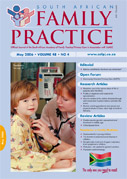Alcohol and drug problems and sexual and physical abuse at three urban high schools in Mthatha
Abstract
Background Alcohol is the most important substance of abuse in South Africa. There are, however, reports of an increase in the use of other drugs among adolescents. The aim of this study was to assess the use of alcohol and other drugs of abuse and their association with physical or sexual abuse in three urban high schools in Mthatha. Method The Alcohol Use Disorders Identification Test (AUDIT), embedded in a broader questionnaire, was used as a screening tool to assess primary and secondary objectives among the student population (N = 1 424) attending school on a given day at three urban high schools in Mthatha (a cut-off point of 8 was selected). Results Of the 266 (18.6%) students who tested AUDIT positive, 63 (4.42%) were female and 203 (14.26%) were male (P less than 0.01). AUDIT-positive students between the ages of 15 and 17 years represent 10.18% of the total number of students tested. A total of 169 (11.87%) students showed symptoms of dependence, while 355 students (24.93%) reported drug-related problems in their families. Two hundred and twenty-five (15.8%) of the students admitted using dagga (cannabis) at some point, while 69 (4.85%) had used mandrax and 64 (4.49%) had used cocaine. A total of 149 (10.46%) students had been victims of physical abuse and 91 (6.39%) of sexual abuse. Sexual and physical abuses were statistically significantly correlated with alcohol-related problems. Conclusions Alcohol was the most commonly abused drug in the screened group, followed by cannabis, mandrax and cocaine. Sexually or physically abused students were at a higher risk of developing a substance-related problem. (SA Fam Pract 2006;48(4): 17)
Issue
Section
Original Research
By submitting manuscripts to SAFP, authors of original articles are assigning copyright to the South African Academy of Family Physicians. Copyright of review articles are assigned to the Publisher, Medpharm Publications (Pty) Ltd, unless otherwise specified. Authors may use their own work after publication without written permission, provided they acknowledge the original source. Individuals and academic institutions may freely copy and distribute articles published in SAFP for educational and research purposes without obtaining permission.

